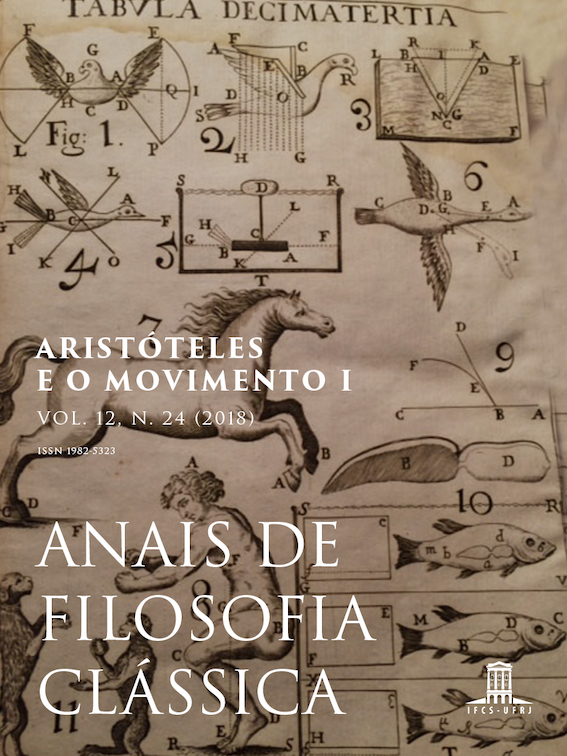Geometrical premises in Aristotle’s Incessu Animalium and kind-crossing
DOI:
https://doi.org/10.47661/afcl.v12i24.26081Parole chiave:
Aristotle, explanation, causality, kind-crossing, locomotion, essencialismAbstract
At some point in the Incessu Animalium, Aristotle appeals to some geometrical claims in order to explain why animal progression necessarily involves the bending (of the limbs), and this appeal to geometrical claims might be taking as violating the recommendation to avoid “kind-crossing” (as found in the Posterior Analytic). But a very unclear notion of kind-crossing has been assumed in most debates. I will argue that kind-crossing in the Posterior Analyticsdoes not mean any employment of premises from a discipline other than that to which the explanandumbelongs. Kind-crossing was meant to cover a specific sort of employment of premises from a different discipline, namely, the case in which premises from a discipline X are taken as the most important explanatory factor that delivers the fullest appropriate explanation of an explanandumwithin discipline Y. If this is so, the employment of geometrical premises in the Incessu Animaliumis not an instance of the prohibited kind-crossing, but something that is in line with the theory of the Posterior Analytics.Riferimenti bibliografici
Primary sources:
BEKKER, I. 1831. Aristotelis Opera, 2 vols., Berlin: Georg Reims.
HAYDUCK, M. 1904. Michaelis Ephesii in libros De Partibus Animalium, de Animalium Motione, de Animalium Incessu Commentaria, Berlin: Georg Reims.
LOUIS, Pierre. 1973. Aristote - Marche des Animaux, Movement des Animaux, Index des Traités Biologiques, Paris: Les Belles Lettres.
ROSS, W. D. 1949. Aristotle’s Prior and Posterior Analytics. Oxford: Oxford UP.
Secondary literature:
BARNES, Jonathan. 1993. Posterior Analytics, Oxford: Oxford University Press.
FARQUHARSON, A. S. L. 1984. Aristotle - Progression of Animals, in Barnes, J. (ed.), The Complete Works of Aristotle: the Revised Oxford Translation, Princeton: Princeton University Press.
FORSTER, E. S. 1936. Aristotle - Movement of animals, Progression of animals, Cambridge, Massachusetts, Harvard University Press (Loeb).
FREY, Christopher. (forthcoming). “Aristotle’s Mathematical Kinesiology: The Case of Bending in De Incessu Animalium 9”.
HANKINSON, Robert J. 2005. “Aristotle on Kind-Crossing”, in Sharples, R. W. (ed.), Philosophy and the Sciences in Antiquity”, Aldershot: Ashgate, p. 23-54.
HASPER, P. S. 2006. “Sources of delusion in Analytica Posteriora I 5”. Phronesis 51, 252-284.
HUSSEY, Edward. 1991. “Aristotle’s Mathematical Physics: a Reconstruction”, in Judson. L. (ed.), Aristotle’s Physics: a Collection of Essays, Oxford, Clarendon Press, p. 213-242.
JUDSON, Lindsay. 2015. “Aristotle’s Astrophysics”, Oxford Studies in Ancient Philosophy 49, p. 151-192.
LENNOX, James G. 2001a. “Material and Formal Natures in Aristotle’s De Partibus Animalium”, in Aristotle’s Philosophy of Biology, Cambridge: Cambridge University Press, p. 182-204.
_________. 2001b. “Nature Does Nothing in Vain…”, in Aristotle’s Philosophy of Biology, Cambridge: Cambridge University Press, p. 205-223.
_________. 2008. “‘As If We Were to Investigate Subness’: Aristotle on the Prospects for a Single Science of Nature”, Oxford Studies in Ancient Philosophy 35, p. 149-186.
LOUIS, Pierre. 1973. Aristote - Marche des Animaux, Movement des Animaux, Index des Traités Biologiques, Paris: Les Belles Lettres.
MCKIRAHAN, Richard. 1992. Principles and Proofs. Aristotle’s Theory of Demonstrative Science, Princeton: Princeton University Press.
MIGNUCCI, Mario. 2007. Aristotele - Analitici Secondi. Roma-Bari: Laterza.
NUSSBAUM, Martha C. 1978. Aristotle’s Motu Animalium, Princeton” Princeton University Press.
STEINKRÜGER, Philipp. 2018. “Aristotle on Kind-Crossing”, Oxford Studies in Ancient Philosophy 54, p. 107-158.
ZUPPOLINI, Breno. 2018. “Explanation and essence in Posterior Analytics II 16-17”, Archai 24, p. 229-264.


